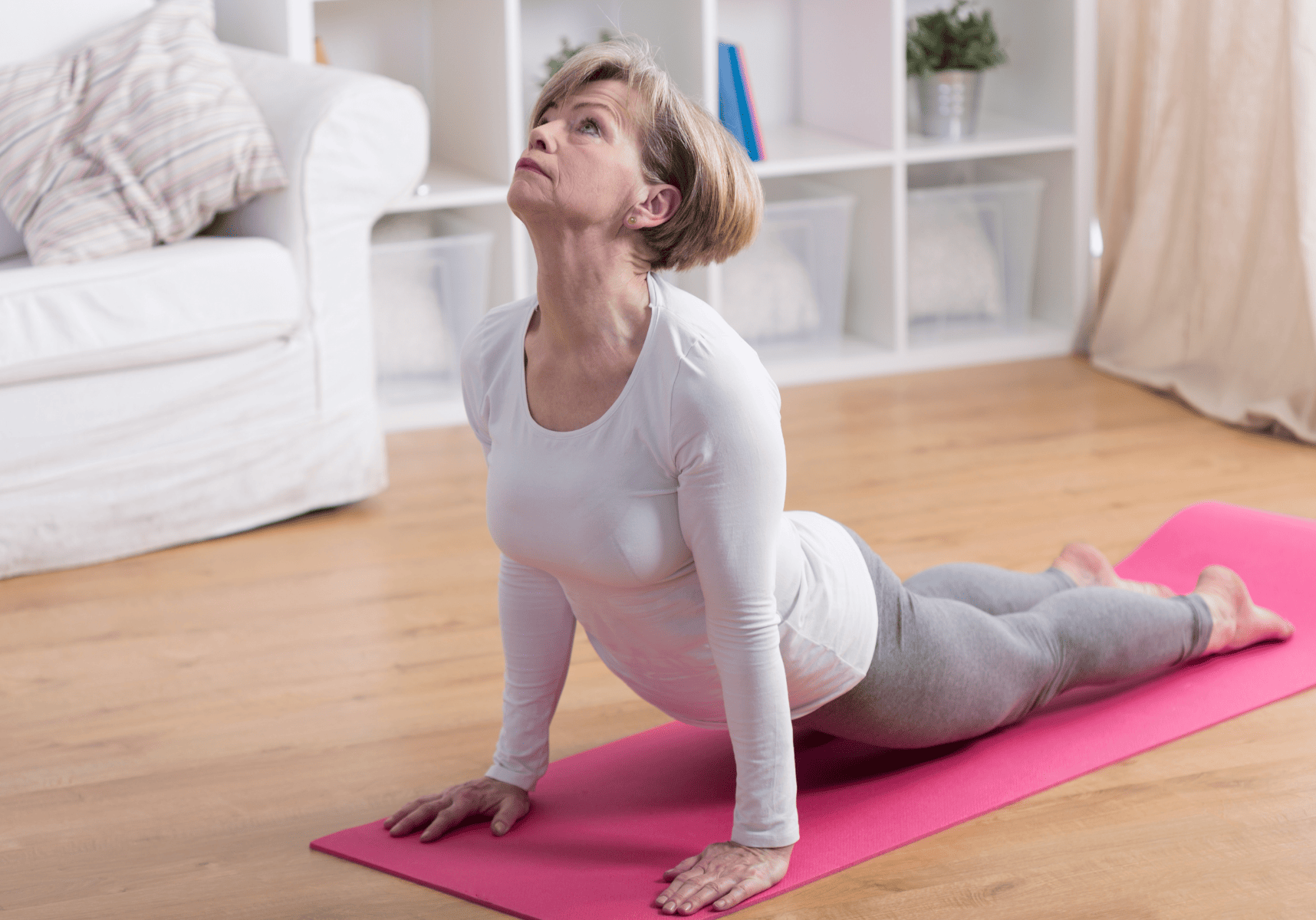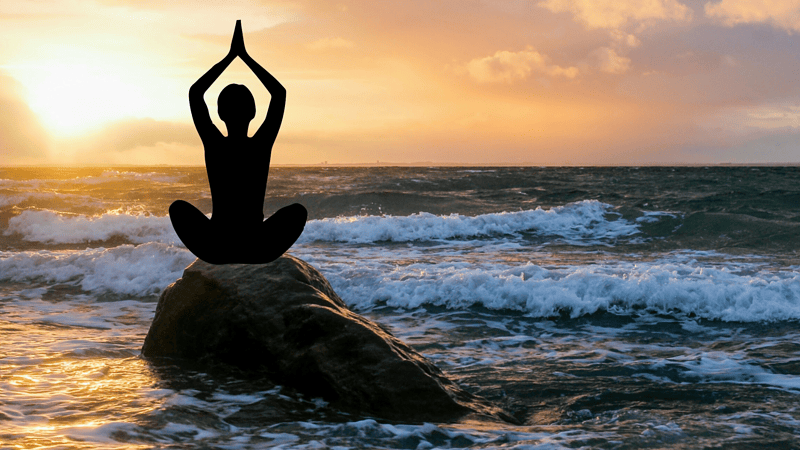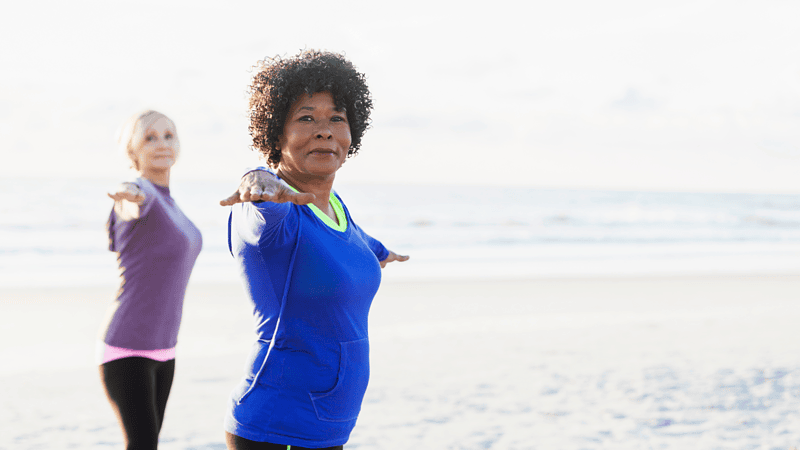
Yoga Asanas for Fall Prevention in Older Adults
Building Balance, Strength, and Flexibility to Safeguard Independence- By Beth Rush
Reading time: 4 minutes
Falls can strip older adults of their independence, but practicing these yoga asanas builds balance, flexibility and strength.
Doctors often tell older adults to exercise but provide little instruction on what to do and how. What are the best activities for fall prevention among this population? Practicing certain yoga asanas for fall prevention in the elderly builds balance, strength and flexibility.
Working on these moves prevents falls before they occur and helps you recover more quickly if you do tumble. Here’s how yoga balance reduces fall risk in seniors and five asanas to add to your daily routine.
How Yoga Balance Reduces Fall Risk in Seniors
According to the Centers for Disease Control and Prevention, falls and motor vehicle accidents lead the way in causing injuries among older adults. One in four adults over 65 will fall in the coming year, and one in five will sustain a serious injury. Bones, muscles and connective tissues don’t knit as quickly in this population, and a broken hip can result in weeks of inactivity and the associated health risks.
Yoga balance reduces fall risk in seniors by building balance, strength and flexibility among older adults. Balance prevents falls from happening or helps you quickly regain your steadiness if you do tumble. Strength gives you the requisite muscle power to return your body to an upright position, and flexibility prevents excessive tissue tearing that can hinder mobility. This ancient practice also engages two of your “other” senses that don’t get as much love as the big five.
1. Proprioception
Proprioception is your perception of where your body is in space and how it moves through it without engaging your visual sense. An example of this is closing your eyes and touching the tip of your nose with your fingertip. Improving your proprioception builds recognition of which movements leave you off-balance and how to adjust them to protect your safety.
2. Interoception
Interoception refers to your perception of sensations arising from within your body — for example, you use it to detect a headache. Learning to tune into it can alert older adults to balance challenges. For example, some people develop vertigo as a result of various diseases, and recognizing when you feel “off” and taking additional precautions can prevent falls.
Best Yoga Asanas for Fall Prevention in the Elderly
Yoga practice varies widely from style to style and guide to guide. Here’s what you should know about the best asanas for fall prevention in the elderly.
What Yoga Style Is Best for Older Adults?
While there are 90-year-olds who kick butt in marathons, many older adults may find vigorous styles like Ashtanga challenging. Hatha yoga is an excellent starting point for many but talk to your guide. This classification has become somewhat of a catchall in recent years, and classes may vary widely in intensity.
Vinyasa and power yoga engage those with a need for greater intensity to build strength and balance. Restorative yoga is slower paced, although it and Yin, with their emphasis on passive poses, may not help as much with balance and strength. Your ideal flow should include standing poses and be just fast enough to let you follow along with only a slight struggle.
Yoga Asanas for Fall Prevention
Regardless of which yoga style you choose, incorporating these five asanas aids in fall prevention. Practice them daily as part of your flow or independently as you have time. Ten minutes can make a significant difference in maintaining your independence.
1. Tree Pose
Here’s a great one for balance. Begin by shifting your weight to one leg. Then, externally rotate the hip of the non-standing leg, either placing the palm of the foot against the ankle or calf or bringing it all the way to your thigh. Avoid putting it directly on the knee to prevent undue pressure on this joint.
2. Revolved Triangle
Here’s a mixed balance and flexibility move that rocks your proprioception. Step your feet approximately three feet apart with your front toes facing forward and your back foot pivoted to 45 degrees. Shift your hips toward the back foot as you rotate your torso and lean down, reaching your opposite hand toward your forward toe. You can support yourself against your calf, use a block or take the first two toes if you’re super flexible.
3. Dancer Pose
Here’s another balance challenge — use a chair or a wall if you feel wobbly. Shift all your weight to one leg as you locate your center of gravity. Lean forward as you lift one leg behind you, holding on to the ankle. Try to bring your torso as close to parallel to the ground as possible.
4. Crescent Lunge
This move strengthens your legs while working balance. Step back about four feet so that you can bend your front leg and bring your thigh parallel with the ground without your knee extending past your toe. Raise your hands toward the sky as you feel your back arch slightly.
5. Boat Pose
Core strength is key to balance. Begin seated, raising your legs and torso so that your body forms a V. Bend your knees to bring your calves parallel to the floor if desired. If you have lower back issues, begin supine and elevate your shoulders, head and legs by engaging your abs, keeping your lower back pressed into the mat.
Preventing Falls in the Elderly With Yoga Balance Asanas for Seniors
Yoga asanas prevent falls in the elderly by improving strength, balance and flexibility. Although any form will do, these poses rock the muscle groups most likely to keep you upright.
Understanding how yoga balance reduces fall risk for seniors can inspire your practice. Spending time on the mat can result in greater independence and quality of life.








